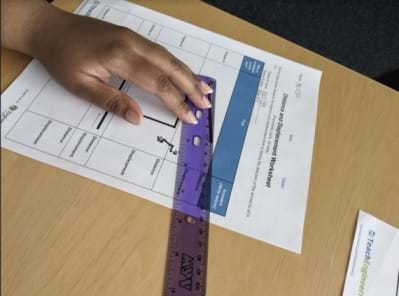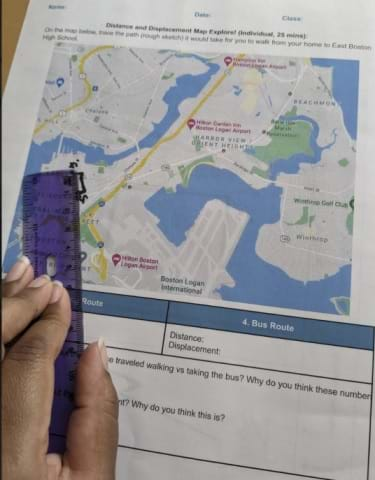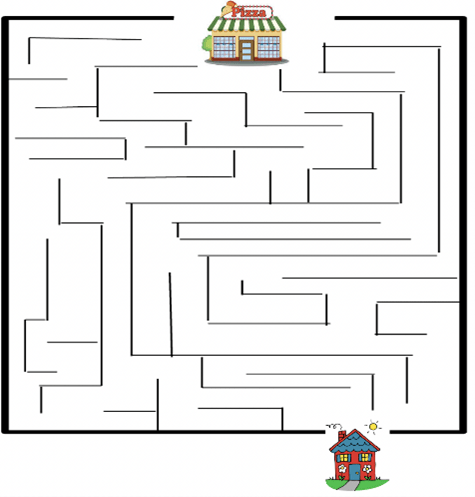Quick Look
Grade Level: 9 (9-10)
Time Required: 1 hours 15 minutes
Expendable Cost/Group: US $0.00
Group Size: 2
Activity Dependency: None
Subject Areas: Measurement, Physics

Summary
Students hone their understanding of distance and displacement, and how to distinguish between the two. The level of difficulty becomes greater as students move through each section of the activity. This activity can help students to visualize and apply the concepts of distance and displacement to their everyday lives. Students practice measuring distance and displacement by mapping out their routes to school, and by making their own routes that will then be student tested. This activity serves as a good way to reaffirm physics concepts, and as a way for students to practice skills such as measuring and collecting time.Engineering Connection
Robotics engineers specialize in designing, building, and programming robotic systems. They would be central to the development of a delivery robot, working on tasks such as path planning, navigation algorithms, and sensor fusion to enable the robot to autonomously navigate its environment.
Related: Transportation engineering focuses on designing and optimizing transportation systems, including vehicles, infrastructure, and logistics. Engineers in this field would contribute to the design of efficient delivery routes and the integration of delivery robots into existing transportation networks.
Learning Objectives
After this activity, students should be able to:
- Explain that distance is the sum of all paths traveled.
- Explain that displacement is a measurement of the direct path from a starting position to an ending position.
- Explain the difference between distance and displacement.
Educational Standards
Each TeachEngineering lesson or activity is correlated to one or more K-12 science,
technology, engineering or math (STEM) educational standards.
All 100,000+ K-12 STEM standards covered in TeachEngineering are collected, maintained and packaged by the Achievement Standards Network (ASN),
a project of D2L (www.achievementstandards.org).
In the ASN, standards are hierarchically structured: first by source; e.g., by state; within source by type; e.g., science or mathematics;
within type by subtype, then by grade, etc.
Each TeachEngineering lesson or activity is correlated to one or more K-12 science, technology, engineering or math (STEM) educational standards.
All 100,000+ K-12 STEM standards covered in TeachEngineering are collected, maintained and packaged by the Achievement Standards Network (ASN), a project of D2L (www.achievementstandards.org).
In the ASN, standards are hierarchically structured: first by source; e.g., by state; within source by type; e.g., science or mathematics; within type by subtype, then by grade, etc.
NGSS: Next Generation Science Standards - Science
-
SEP.12.9-12.4.
Use mathematical representations of phenomena or design solutions to describe and/or support claims and/or explanations.
(Grades 9 - 12)
More Details
Do you agree with this alignment?
Common Core State Standards - Math
-
Use appropriate tools strategically.
(Grades
K -
12)
More Details
Do you agree with this alignment?
-
Summarize, represent, and interpret data on a single count or measurement variable
(Grades
9 -
12)
More Details
Do you agree with this alignment?
Materials List
For each group:
- a ruler with cm
- a computer/phone with timer
- a spool or of string
For the teacher:
- a computer
Worksheets and Attachments
Visit [www.teachengineering.org/activities/view/bos-2802-distance-displacement-measurement-activity] to print or download.Pre-Req Knowledge
Students are expected to:
- Know how to use a ruler and timer.
- Be familiar with the concepts of distance and displacement.
Introduction/Motivation
We have previously discussed distance and displacement. As a review, who can tell me what distance is? (Answer: The extent or amount of space between two things, points, lines, etc.) Who can tell me what displacement is? (Answer: The moving of something from its place or position; the change in position of something.)
In today’s activity, we are going to visualize these concepts to better understand the difference between them.
(Show students the 1:32-minute Food Delivery Robot Ad video.)
After watching that video, what are the benefits of using this technology to deliver pizza? What are the drawbacks? (Let students offer suggestions.)
As the engineer creating this “Nuro” delivery robot, what kinds of things do you think you would have to consider? (Based on student answers, prompt students to think about mapping the route and prod them for ideas about distance/displacement.)
Thinking about the food delivery robot, today we are going to collect data on distance and displacement for our routes to and from school.
Procedure
Before the Activity
- Decide which map to use in the Distance and Displacement Worksheet and insert it into the Word document. The map provided in the attached worksheet is of East Boston. Change the map to fit your local school community.
NOTE:
- In communities where public transport is the main mode of travel for students, consider replacing the Boston map with one of your community that includes bus/train routes.
- In communities where students are driven to school by guardians or the bus, consider replacing the Boston map with one of your community that includes major and minor roads.
- In the Distance and Displacement Worksheet: For the Exit ticket, you can replace “a friend’s house” with a well-known landmark from the community you teach in.
- Make copies of the Distance and Displacement Worksheet, one per student.
- Arrange students into groups of two, or keep them working individually if you have enough materials.
With the Students
Part 1: Introduction / Pre-Activity (15 min)
- Go over the Introduction / Motivation section.
- Give each student a copy of the Distance and Displacement Worksheet.
- Give each student a ruler with centimeters.
- Have students complete Section 1 of the Distance and Displacement Worksheet (practicing measuring distance and displacement). They will need a ruler.
- Students who finish early can help classmates or discuss answers.
Part 2: Distance and Displacement Map – Explore! (25 min)
- Have students work through Section 2 of the Distance and Displacement Worksheet. Note: The attached worksheet uses our local map; you may want to substitute this map with a map of your own area.
- Students should map their route between school and home using distance and displacement individually. Notes:
- Students may use their phones (or computers if they do not have access to phones) to look at Google Maps.
- Students will need a ruler, and string (for more complicated paths).

Part 3: Design Challenge (30 min)
- Have students complete Section 3 of the Distance and Displacement Worksheet (making a maze for a peer to test) and answer the reflection questions. Students will need a ruler, string, and a timer. See example of a maze below:

- For the Exit ticket, you can replace “a friend’s house” with a well-known landmark from the community you teach in.
Part 4: Conclusion (5-10 min)
- Wrap up the activity with a brief review of what distance is and what displacement is. (Answer: Distance is the length of the path taken by an object. Displacement is the distance between where the object started and where it ended up.)
- Have students share one thing they learned from this activity.
Vocabulary/Definitions
displacement: The measurement of the direct path from a starting position to an ending position; includes direction.
distance: The sum of all paths traveled.
Assessment
Pre-Activity Assessment
The first worksheet serves as a warm-up to have students determine how to find distance and displacement. Based on student performance, you may choose to spend more time going over the content or move on if students demonstrate competency.
Activity Embedded (Formative) Assessment
Students explore the difference between distance and displacement in the Distance and Displacement Worksheet. There is an opportunity for formative assessment by walking around and listening to partners share ideas about how to calculate distance and displacement.
Post-Activity (Summative) Assessment
After the design challenge, students are asked reflection questions that require them to think critically about the real-world applications of distance and displacement. These reflections provide opportunities for students to think critically and for the teacher to assess content understanding.
Investigating Questions
- How do we describe how far we are from a location?
- How are distance and displacement different?
Troubleshooting Tips
Explain to students how to make a maze; show them the example listed in Part 3 of the procedure.
Individualize the map in the Distance and Displacement Worksheet to your own area.
- In communities where public transport is the main mode of travel for students, consider replacing the Boston map with one of your community that includes bus/train routes.
- In communities where students are driven to school by guardians or the bus, consider replacing the Boston map with one of your community that includes major and minor roads.
Activity Extensions
This activity is a great segue to teach students the difference between speed and velocity. An additional option for extension (as mentioned in the Engineering Connection section) is for students to use the concepts of distance and displacement of neighborhood planning to reimagine their neighborhood, making it easier to get to school without moving their houses, the school, or any other buildings.
Subscribe
Get the inside scoop on all things TeachEngineering such as new site features, curriculum updates, video releases, and more by signing up for our newsletter!More Curriculum Like This

High school students learn how engineers mathematically design roller coaster paths using the approach that a curved path can be approximated by a sequence of many short inclines. They apply basic calculus and the work-energy theorem for non-conservative forces to quantify the friction along a curve...
Copyright
© 2024 by Regents of the University of Colorado; original © 2021 Boston UniversityContributors
Shereen Mejia, Boston Public Schools @ East Boston High School; Victoria Bartow, Boston Public Schools @ Edward M. Kennedy Academy for Health CareersSupporting Program
NSF Research Experience for Teachers (RET) in Integrated Nanomanufacturing at the Photonics Center, Boston UniversityAcknowledgements
This curriculum was based upon work supported by the National Science Foundation under RET grant no. EEC 1407165—at the Research Experience for Teachers in Integrated Nanomanufacturing at the Photonics Center at Boston University. Any opinions, findings, and conclusions or recommendations expressed in this material are those of the authors and do not necessarily reflect the views of the National Science Foundation.
Last modified: May 17, 2024







User Comments & Tips